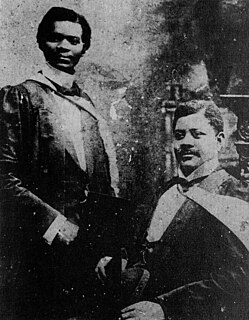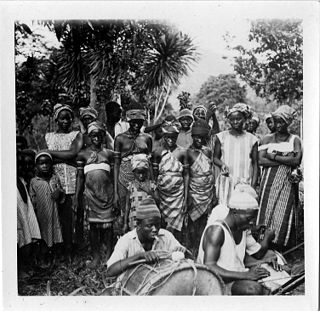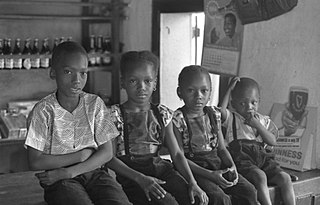Sierra Leone first became inhabited by indigenous African peoples at least 2,500 years ago. The dense tropical rainforest partially isolated the region from other West African cultures, and it became a refuge for peoples escaping violence and jihads. Sierra Leone was named by Portuguese explorer Pedro de Sintra, who mapped the region in 1462. The Freetown estuary provided a good natural harbour for ships to shelter and replenish drinking water, and gained more international attention as coastal and trans-Atlantic trade supplanted trans-Saharan trade.

Freetown is the capital and largest city of Sierra Leone. It is a major port city on the Atlantic Ocean and is located in the Western Area of the country. Freetown is Sierra Leone's major urban, economic, financial, cultural, educational and political centre, as it is the seat of the Government of Sierra Leone. The population of Freetown was 1,055,964 at the 2015 census.

Sierra Leone's music is a mixture of native, French, British, West Indian and Creole musical genres.
Sierra Leonean Creole or Krio is an English-based creole language that is lingua franca and de facto national language spoken throughout the West African nation of Sierra Leone. Krio is spoken by 87% of Sierra Leone's population and unites the different ethnic groups in the country, especially in their trade and social interaction with each other. Krio is the primary language of communication among Sierra Leoneans at home and abroad. The language is native to the Sierra Leone Creole people or Krios,, and is spoken as a second language by millions of other Sierra Leoneans belonging to the country's indigenous tribes. English is Sierra Leone's official language, while Krio, despite its common use throughout the country, has no official status.
The Aku, Krio, or Creole are a minority ethnic group of Gambia with roots among the Sierra Leone Creole people.
Maroon Town, Sierra Leone, is a district in the settlement of Freetown, a colony founded in West Africa by Great Britain.
The Sierra Leone Police (SLP) is the national police force of the Republic of Sierra Leone, that is primarily responsible for law enforcement and crime investigation throughout Sierra Leone. The Sierra Leone Police is part undet the jurisdiction of the Sierra Leone Ministry of Internal Affairs, a cabinet ministry in the Government of Sierra Leone.

The East and West Africa Medal, established in 1892, was a campaign medal awarded for minor campaigns that took place in East and West Africa between 1887 and 1900. A total of twenty one clasps were issued.
Sierra Leone assumed its present large geographical size only in 1896. Prior to that, it was only a small colony encompassing roughly the 30-km-long peninsula on which Freetown is located. Initially, the British and Creoles of the Freetown colony had only a very limited involvement in the affairs of the African kingdoms around them; such as it was, it consisted mostly of trading and missionary activity. Over the course of the 19th century this involvement gradually increased. The colonial government was, in particular, interested in fostering trade as this provided it with its main source of revenue, in the form of customs duties and other taxes. This inevitably drew it into engagement with the African kingdoms, mainly by making treaties with the kingdoms or sending military expeditions against them.

In April 1961, Sierra Leone became politically independent of Great Britain. It retained a parliamentary system of government and was a member of the British Commonwealth of Nations. The Sierra Leone People's Party (SLPP), led by Sir Milton Margai were victorious in the first general election under universal adult franchise in May 1962. Upon Sir Milton's death in 1964, his half-brother, Sir Albert Margai, succeeded him as Prime Minister. Sir Albert attempted to establish a one-party state had the ready cooperation of the opposition All People' Congress but met fierce resistance from some cadre within his party Sierra Leone People's Party (SLPP) and ultimately abandoned the idea.
Robert Benjamin Ageh Wellesley Cole, was a Sierra Leonean medical doctor who was the first West African to become a Fellow of the Royal College of Surgeons of England.
Freetown City Council is the municipal government of the city of Freetown, the capital of Sierra Leone. The Freetown City Council was established in 1893 and is one of the oldest municipal government in Africa.The Freetown City Hall, located on Wallace-Johnson Street, is the meeting place and seat of government of the Freetown City Council

Macormack Charles Farrell Easmon, OBE, popularly known as M. C. F. Easmon or "Charlie", was a Sierra Leone Creole born in Accra in the Gold Coast, where his father John Farrell Easmon, a prominent Creole doctor, was working at the time. He belonged to the notable Easmon family of Sierra Leone of African-American descent.

Saros, or Creoles in Nigeria during the nineteenth century and early twentieth century, were freed slaves who migrated to Nigeria in the beginning of the 1830s. They were known locally as saros or Amaros: migrants from Brazil and Cuba. Saros and Amaros also settled in other West African countries such as the Gold Coast (Ghana). They were mostly freed and repatriated slaves from various West African and Latin American countries such as Sierra Leone, Brazil and Cuba. Liberated "returnee" Africans from Brazil were more commonly known as "Agudas", from the word àgùdà in the Yoruba language. Most of the Latin American returnees or Amaros started migrating to Africa after slavery was abolished on the continent while others from West Africa, or the Saros were recaptured and freed slaves already resident in Sierra Leone. Many of the returnees chose to return to Nigeria for cultural, missionary and economic reasons. Many of them were originally descended from the Yoruba of western and central Nigeria. Other Nigerian groups forming part of the Sierra Leonean Krio population included Efik, Igbos, Hausa and Nupe.
The Yoni Expedition was British campaign launched in 1887 against the Yoni Chiefdom of the Temne people of Sierra Leone.
The Yoni Chiefdom is a Chiefdom of Sierra Leone located in Tonkolili District, Northern Province, Sierra Leone. It is centred on Yonibana and the Yoni people are part of the Temne ethnic group.

The Easmon family or the Easmon Medical Dynasty is a Sierra Leone Creole medical dynasty of African-American descent originally based in Freetown, Sierra Leone. The Easmon family has ancestral roots in the United States, and in particular Savannah, Georgia and other states in the American South. There are several descendants of the Sierra Leonean family in the United Kingdom and the United States, and in Accra, Ghana and Kumasi, Ghana. The family produced several medical doctors beginning with John Farrell Easmon, the medical doctor who coined the term Blackwater fever and wrote the first clinical diagnosis of the disease linking it to malaria and Albert Whiggs Easmon, who was a leading gynaecologist in Freetown, Sierra Leone. Several members of the family were active in business, academia, politics, the arts including music, cultural dance, playwriting and literature, history, anthropology, cultural studies, and anti-colonial activism against racism.









